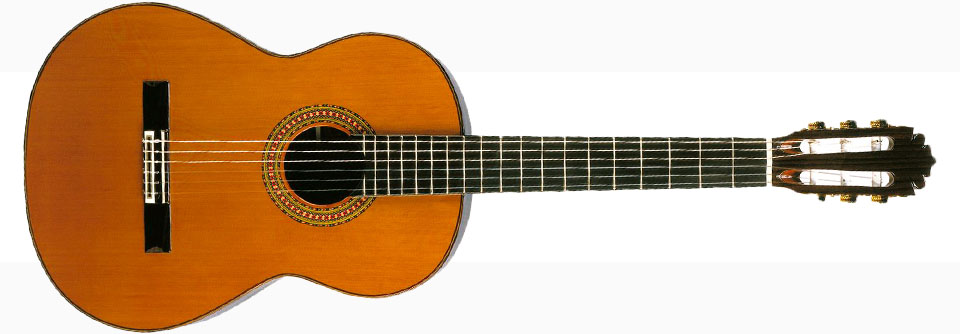What is Classical Guitar?
So what exactly is classical guitar? With so many styles of guitar in the world today, it can be confusing to distinguish between each one.
However, there are three things that separate classical guitar (also called spanish guitar, or classic guitar) from other styles of guitar... the instrument, the playing technique, and the music.
The Instrument
Nowadays, you can find guitars of every imaginable size, shape, and sound. Acoustic guitars, electric guitars, steel string guitars, flamenco guitars, slide guitars, jazz guitars... the list goes on and on.
However, classical guitarists always play one specific type of guitar, called a... you guessed it... "classical guitar." A typical classical guitar looks like this:

Now, you may be asking, how is this guitar different from every other guitar in the world? It has 6 strings, several frets, a sound hole, and other features you find on most guitars. However, a classical guitar is unique because:
- The strings are made of nylon - classical guitar strings are generally made from nylon (or other similar-sounding materials such gut, or carbon), which produce a rich, warm sound. Most other guitars have steel strings which produce a brighter sound.
- The fretboard is slightly wider - a classical guitar fretboard is built slightly wider than on most guitars to make it easier to play complicated finger techniques.
- The neck is slightly shorter - the neck of a classical guitar is slightly shorter... partly due to tradition, and partly because it makes playing easier.
- The body is hollow - a classical guitar always has a hollow body, which allows it to produce a rich, resonant sound - even without amplification. Many other types guitars have a hollow body too, but other guitars have a "solid" body.
- There is a "rosette" around the sound hole - On a classical guitar, you will always find a beautiful, decorative design - called a "rosette" - around the sound hole. This has no functional purpose... just aesthetic!
The Playing Technique
Just like you can find hundreds of different types of guitar, you will see thousands of different techniques for playing the guitar. Some guitarists pluck with a pick while others pluck with the fingers. Some guitarists use a large amount of amplification and distortion, while others play with a natural "acoustic" sound.
However, there are few things that separate classical guitar playing technique from other styles of guitar:
- Plucking the strings with the fingers - a classical guitarist plucks the strings with the thumb, index, middle, and ring fingers. This is often called "fingerstyle" technique. Note that a classical guitarist does not use a guitar pick.
- Using fingernails to play - a classical guitarist usually plays with fingernails in order to produce a loud, clean, and resonant sound.
- Playing with a natural "acoustic" sound - classical guitarists usually play with a natural "acoustic" sound, which means they do not use any amplification or electronic distortion (although sometimes the guitar is amplified with a microphone).
- Holding the guitar in place with a support - A classical guitarist uses some kind of guitar support to hold the guitar in a good playing position. There are many different types of supports that a guitarist might use, such as a foot stool, a strap, or an attachable support.
- Trying to play "clean" - A classical guitarist usually tries to play without making any buzzing sounds, nail noise, missed notes, etc. This is called playing "clean."
- Generally producing a warm, rich tone - Usually, a classical guitarist tries to produce a warm, rich, mellow tone when playing. This will vary from guitarist to guitarist however.
The Music
The guitar is perhaps one of the most versatile instruments in the world. It can play music from just about every genre... from jazz, to funk, to reggae, to flamenco.
However, classical guitarists only play music from one genre, called "classical music."
What is classical music? It is a musical style that comes from the European liturgical music and secular music traditions. You've probably heard compositions of some of the most famous classical musicians such as Bach, Beethoven, Mozart and Brahms.
Some of the defining features of classical music include:
- The music is written in staff notation - Composers always write classical music in staff music notation. This is probably the most important thing that separates classical music form other genres.
- The music is performed exactly "as written" - classical music is performed exactly the way it is written in the staff music. In other words, there is very little improvising, altering, or adding to the piece by the performer.
- Music ranges from Renaissance to Contemporary - classical music spans a wide time frame, from about 1400 C.E to the modern era. This includes many important musical eras, such as Renaissance, Baroque, Classical, Romantic, and more.
- Music comes form many different cultures - unlike other musical genres which primarily come from one specific culture, classical music now comes from a wide variety cultures. For instance, you will find classical guitar music from Brazil, Spain, Cuba, Germany, Italy, England, Japan, and more.
- Music incorporates many different styles - as a result of the long history and the various cultural influence, classical music now incorporates a wide range of musical styles. For instance, classical music has recently incorporated elements of jazz, pop, impressionism, and more.
Copyright 2014 © ClassicalGuitar101.org | All Rights Reserved
Popular Articles:
Making a Living as a classical guitarist
List of Classical Guitar Competitions
About Me
My name is Daniel Nelson, and I am a classical guitar teacher and performer from Los Angeles, California. Click here to learn more.
Leave a Comment!